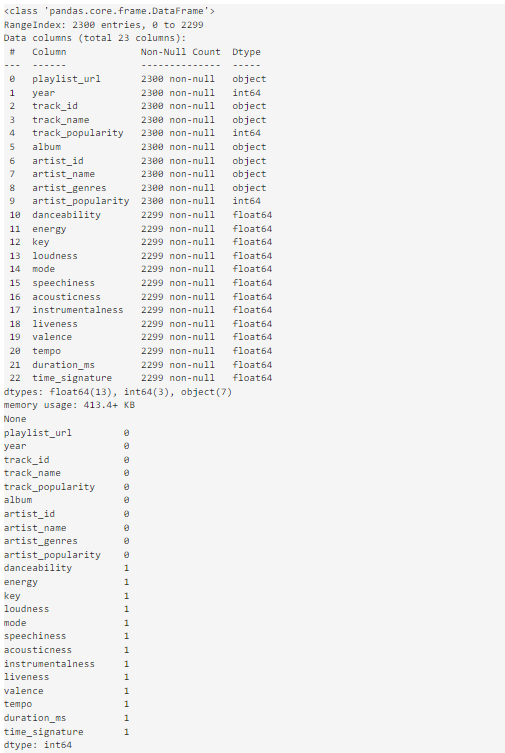
Unsupervised Clustering: Can We Identify Clusters in the Descriptions of Sounds in Music?
Last Updated on June 4, 2024 by Editorial Team
Author(s): Greg Postalian-Yrausquin
Originally published on Towards AI.
The data used is tricky because it is a list of Spotify songs, which are assigned values that describe the sounds in them. At this point, the goal is to see if those descriptions can be used to identify the music genre or the artist.
import numpy as np
import pandas as pd
from sklearn.decomposition import PCA
from sklearn.cluster import KMeans
from sklearn.cluster import AgglomerativeClustering
from sklearn.cluster import Birch
from sklearn.cluster import OPTICS
from sklearn.cluster import DBSCAN
from sklearn.metrics import silhouette_samples, silhouette_score, calinski_harabasz_score
from sklearn.preprocessing import StandardScaler
import matplotlib.pyplot as plt
import matplotlib.cm as cm
import seaborn as sns
import warnings
import ast
Load dataset and show a quick description and sample
dataset = pd.read_csv("playlist_2010to2022.csv")
print(dataset.info())
print(dataset.isna().sum())
print(dataset.describe())
dataset.head(10)



From this dataset I will select the sound attributes of the songs. I am also saving the metadata appart
dataset = dataset.set_index('track_id')
dataset = dataset.dropna()
metadata = dataset[['track_name','album','artist_id','artist_name','artist_genres','year']]
dataset = dataset[['danceability','energy','key','loudness','speechiness','acousticness','instrumentalness','liveness','valence','tempo','duration_ms','time_signature']]
The following code defines a PCA analysis to reduce the number of variables (might sound as an overkill for this example, but it also serves the purpose to scale the variables properly. In my experience clustering sometimes works better working with principal components than with the actual values). Before the PCA a standard scaler is also run for each column
def varred(simio):
scaler = PCA(n_components=0.85, svd_solver='full')
resultsWordstrans = simio.copy()
resultsWordstrans = scaler.fit_transform(resultsWordstrans)
resultsWordstrans = pd.DataFrame(resultsWordstrans)
resultsWordstrans.index = simio.index
resultsWordstrans.columns = resultsWordstrans.columns.astype(str)
return resultsWordstrans
def properscaler(simio):
scaler = StandardScaler()
resultsWordstrans = scaler.fit_transform(simio)
resultsWordstrans = pd.DataFrame(resultsWordstrans)
resultsWordstrans.index = simio.index
resultsWordstrans.columns = simio.columns
return resultsWordstrans
datasetR = properscaler(dataset)
datasetR = varred(datasetR)
First, I will review the metrics, setting in maximum of 20 clusters to determine the number of clusters using the silhouette and the Calinski Harabasz score.
a = []
X = datasetR.to_numpy(dtype='float')
for ncl in np.arange(2, int(20), 1):
clusterer = AgglomerativeClustering(n_clusters=int(ncl))
cluster_labels1 = clusterer.fit_predict(X)
silhouette_avg1 = silhouette_score(X, cluster_labels1)
calinski1 = calinski_harabasz_score(X, cluster_labels1)
clusterer = KMeans(n_clusters=int(ncl))
with warnings.catch_warnings():
warnings.simplefilter("ignore")
cluster_labels2 = clusterer.fit_predict(X)
silhouette_avg2 = silhouette_score(X, cluster_labels2)
calinski2 = calinski_harabasz_score(X, cluster_labels2)
clusterer = Birch(n_clusters=int(ncl))
cluster_labels3 = clusterer.fit_predict(X)
silhouette_avg3 = silhouette_score(X, cluster_labels3)
calinski3 = calinski_harabasz_score(X, cluster_labels3)
row = pd.DataFrame({"ncl": [ncl],
"silAggCl": [silhouette_avg1], "c_hAggCl": [calinski1],
"silKMeans": [silhouette_avg2], "c_hKMeans": [calinski2],
"silBirch": [silhouette_avg3], "c_hBirch": [calinski3],
})
a.append(row)
scores = pd.concat(a, ignore_index=True)
plt.style.use('bmh')
fig, [ax_sil, ax_ch] = plt.subplots(1,2,figsize=(15,7))
ax_sil.plot(scores["ncl"], scores["silAggCl"], 'g-')
ax_sil.plot(scores["ncl"], scores["silKMeans"], 'b-')
ax_sil.plot(scores["ncl"], scores["silBirch"], 'r-')
ax_ch.plot(scores["ncl"], scores["c_hAggCl"], 'g-', label='Agg Clust')
ax_ch.plot(scores["ncl"], scores["c_hKMeans"], 'b-', label='KMeans')
ax_ch.plot(scores["ncl"], scores["c_hBirch"], 'r-', label='Birch')
ax_sil.set_title("Silhouette curves")
ax_ch.set_title("Calinski Harabasz curves")
ax_sil.set_xlabel('clusters')
ax_sil.set_ylabel('silhouette_avg')
ax_ch.set_xlabel('clusters')
ax_ch.set_ylabel('calinski_harabasz')
ax_ch.legend(loc="upper right")
plt.show()

ncl_AggCl = 11
ncl_KMeans = 17
ncl_Birch = 9
X = datasetR.to_numpy(dtype='float')
clusterer1 = AgglomerativeClustering(n_clusters=int(ncl_AggCl))
cluster_labels1 = clusterer1.fit_predict(X)
n_clusters1 = max(cluster_labels1)
silhouette_avg1 = silhouette_score(X, cluster_labels1)
sample_silhouette_values1 = silhouette_samples(X, cluster_labels1)
with warnings.catch_warnings():
warnings.simplefilter("ignore")
clusterer2 = KMeans(n_clusters=int(ncl_KMeans))
cluster_labels2 = clusterer2.fit_predict(X)
n_clusters2 = max(cluster_labels2)
silhouette_avg2 = silhouette_score(X, cluster_labels2)
sample_silhouette_values2 = silhouette_samples(X, cluster_labels2)
clusterer3 = Birch(n_clusters=int(ncl_Birch))
cluster_labels3 = clusterer3.fit_predict(X)
n_clusters3 = max(cluster_labels3)
silhouette_avg3 = silhouette_score(X, cluster_labels3)
sample_silhouette_values3 = silhouette_samples(X, cluster_labels3)
clusterer4 = OPTICS(min_samples=2)
cluster_labels4 = clusterer4.fit_predict(X)
n_clusters4 = max(cluster_labels4)
silhouette_avg4 = silhouette_score(X, cluster_labels4)
sample_silhouette_values4 = silhouette_samples(X, cluster_labels4)
clusterer5 = DBSCAN(eps=1, min_samples=2)
cluster_labels5 = clusterer5.fit_predict(X)
n_clusters5 = max(cluster_labels5)
silhouette_avg5 = silhouette_score(X, cluster_labels5)
sample_silhouette_values5 = silhouette_samples(X, cluster_labels5)
finalDF = datasetR.copy()
finalDF["clAggCl"] = cluster_labels1
finalDF["clKMeans"] = cluster_labels2
finalDF["clBirch"] = cluster_labels3
finalDF["clOptics"] = cluster_labels4
finalDF["clDbscan"] = cluster_labels5
finalDF["silAggCl"] = sample_silhouette_values1
finalDF["silKMeans"] = sample_silhouette_values2
finalDF["silBirch"] = sample_silhouette_values3
finalDF["silOptics"] = sample_silhouette_values4
finalDF["silDbscan"] = sample_silhouette_values5
finalDFf = pd.merge(finalDF, metadata, left_index=True, right_index=True)
finalDFf['artist_genres'] = finalDFf['artist_genres'].apply(lambda x: ast.literal_eval(x))
fig, [ax1, ax2, ax3, ax4, ax5] = plt.subplots(1,5,figsize=(20,20))
ax1.set_xlim([-0.1, 1])
ax1.set_ylim([0, len(X) + (n_clusters1 + 1) * 10])
y_lower = 10
for i in range(min(cluster_labels1),max(cluster_labels1)+1):
ith_cluster_silhouette_values = sample_silhouette_values1[cluster_labels1 == i]
ith_cluster_silhouette_values.sort()
size_cluster_i = ith_cluster_silhouette_values.shape[0]
y_upper = y_lower + size_cluster_i
color = cm.nipy_spectral(float(i) / n_clusters1)
ax1.fill_betweenx(
np.arange(y_lower, y_upper),
0,
ith_cluster_silhouette_values,
facecolor=color,
edgecolor=color,
alpha=0.7,
)
ax1.text(-0.05, y_lower + 0.5 * size_cluster_i, str(i))
y_lower = y_upper + 10 # 10 for the 0 samples
ax1.set_title("Silhouette plot for Agg. Clustering")
ax1.set_xlabel("Silhouette coefficient values")
ax1.set_ylabel("Cluster labels")
ax1.axvline(x=silhouette_avg1, color="red", linestyle="--")
ax1.set_yticks([]) # Clear the yaxis labels / ticks
ax1.set_xticks([-0.1, 0, 0.2, 0.4, 0.6, 0.8, 1])
ax2.set_xlim([-0.1, 1])
ax2.set_ylim([0, len(X) + (n_clusters2 + 1) * 10])
y_lower = 10
for i in range(min(cluster_labels2),max(cluster_labels2)+1):
ith_cluster_silhouette_values = sample_silhouette_values2[cluster_labels2 == i]
ith_cluster_silhouette_values.sort()
size_cluster_i = ith_cluster_silhouette_values.shape[0]
y_upper = y_lower + size_cluster_i
color = cm.nipy_spectral(float(i) / n_clusters2)
ax2.fill_betweenx(
np.arange(y_lower, y_upper),
0,
ith_cluster_silhouette_values,
facecolor=color,
edgecolor=color,
alpha=0.7,
)
ax2.text(-0.05, y_lower + 0.5 * size_cluster_i, str(i))
y_lower = y_upper + 10 # 10 for the 0 samples
ax2.set_title("Silhouette plot for KMeans")
ax2.set_xlabel("Silhouette coefficient values")
ax2.set_ylabel("Cluster labels")
ax2.axvline(x=silhouette_avg2, color="red", linestyle="--")
ax2.set_yticks([]) # Clear the yaxis labels / ticks
ax2.set_xticks([-0.1, 0, 0.2, 0.4, 0.6, 0.8, 1])
ax3.set_xlim([-0.1, 1])
ax3.set_ylim([0, len(X) + (n_clusters3 + 1) * 10])
y_lower = 10
for i in range(min(cluster_labels3),max(cluster_labels3)+1):
ith_cluster_silhouette_values = sample_silhouette_values3[cluster_labels3 == i]
ith_cluster_silhouette_values.sort()
size_cluster_i = ith_cluster_silhouette_values.shape[0]
y_upper = y_lower + size_cluster_i
color = cm.nipy_spectral(float(i) / n_clusters3)
ax3.fill_betweenx(
np.arange(y_lower, y_upper),
0,
ith_cluster_silhouette_values,
facecolor=color,
edgecolor=color,
alpha=0.7,
)
ax3.text(-0.05, y_lower + 0.5 * size_cluster_i, str(i))
y_lower = y_upper + 10 # 10 for the 0 samples
ax3.set_title("Silhouette plot for Birch")
ax3.set_xlabel("Silhouette coefficient values")
ax3.set_ylabel("Cluster labels")
ax3.axvline(x=silhouette_avg3, color="red", linestyle="--")
ax3.set_yticks([]) # Clear the yaxis labels / ticks
ax3.set_xticks([-0.1, 0, 0.2, 0.4, 0.6, 0.8, 1])
ax4.set_xlim([-0.1, 1])
ax4.set_ylim([0, len(X) + (n_clusters4 + 1) * 10])
y_lower = 10
for i in range(min(cluster_labels4),max(cluster_labels4)+1):
ith_cluster_silhouette_values = sample_silhouette_values4[cluster_labels4 == i]
ith_cluster_silhouette_values.sort()
size_cluster_i = ith_cluster_silhouette_values.shape[0]
y_upper = y_lower + size_cluster_i
color = cm.nipy_spectral(float(i) / n_clusters4)
ax4.fill_betweenx(
np.arange(y_lower, y_upper),
0,
ith_cluster_silhouette_values,
facecolor=color,
edgecolor=color,
alpha=0.7,
)
ax4.text(-0.05, y_lower + 0.5 * size_cluster_i, str(i))
y_lower = y_upper + 10 # 10 for the 0 samples
ax4.set_title("Silhouette plot for Optics")
ax4.set_xlabel("Silhouette coefficient values")
ax4.set_ylabel("Cluster labels")
ax4.axvline(x=silhouette_avg4, color="red", linestyle="--")
ax4.set_yticks([]) # Clear the yaxis labels / ticks
ax4.set_xticks([-0.1, 0, 0.2, 0.4, 0.6, 0.8, 1])
ax5.set_xlim([-0.1, 1])
ax5.set_ylim([0, len(X) + (n_clusters5 + 1) * 10])
y_lower = 10
for i in range(min(cluster_labels5),max(cluster_labels5)+1):
ith_cluster_silhouette_values = sample_silhouette_values5[cluster_labels5 == i]
ith_cluster_silhouette_values.sort()
size_cluster_i = ith_cluster_silhouette_values.shape[0]
y_upper = y_lower + size_cluster_i
color = cm.nipy_spectral(float(i) / n_clusters5)
ax5.fill_betweenx(
np.arange(y_lower, y_upper),
0,
ith_cluster_silhouette_values,
facecolor=color,
edgecolor=color,
alpha=0.7,
)
ax5.text(-0.05, y_lower + 0.5 * size_cluster_i, str(i))
y_lower = y_upper + 10 # 10 for the 0 samples
ax5.set_title("Silhouette plot for DBScan")
ax5.set_xlabel("Silhouette coefficient values")
ax5.set_ylabel("Cluster labels")
ax5.axvline(x=silhouette_avg5, color="red", linestyle="--")
ax5.set_yticks([]) # Clear the yaxis labels / ticks
ax5.set_xticks([-0.1, 0, 0.2, 0.4, 0.6, 0.8, 1])

Since I need to select a genre for the next part of the exercise I need first to undo that column, which is a list, but it is written as text, and I will count the number of words in a genre, to remove the composed ones. This will show the unique values of genres.
finalDFf = pd.merge(finalDF, metadata, left_index=True, right_index=True)
finalDFf['artist_genres'] = finalDFf['artist_genres'].apply(lambda x: ast.literal_eval(x))
genres = pd.DataFrame(finalDFf['artist_genres'].explode())
finalDFgen = pd.merge(finalDF, genres, left_index=True, right_index=True)
finalDFgen = finalDFgen.drop_duplicates()
genrestbl = pd.DataFrame(finalDFgen.groupby('artist_genres')['artist_genres'].count()).reset_index(names="genre").sort_values(['artist_genres'], ascending=False)
print(genrestbl.head(100).to_string())

List of genres to select on the next section
selectedgenres = ['rock','reggaeton','house','hip pop','electro house','trap latino', 'punk', 'nu metal', 'pop dance']
filtered = finalDFgen[finalDFgen['artist_genres'].isin(selectedgenres)]
fig, [ax1, ax2, ax3, ax4, ax5] = plt.subplots(5,1, figsize=(10,20))
sns.scatterplot(data=filtered, x="0", y="1", hue="clAggCl", style="artist_genres",s = 200, alpha = 1, palette="Set3", ax=ax1)
sns.scatterplot(data=filtered, x="0", y="1", hue="clKMeans", style="artist_genres",s = 200, alpha = 1, palette="Set3", ax=ax2)
sns.scatterplot(data=filtered, x="0", y="1", hue="clBirch", style="artist_genres",s = 200, alpha = 1, palette="Set3", ax=ax3)
sns.scatterplot(data=filtered, x="0", y="1", hue="clOptics", style="artist_genres",s = 200, alpha = 1, palette="Set3", ax=ax4)
sns.scatterplot(data=filtered, x="0", y="1", hue="clDbscan", style="artist_genres",s = 200, alpha = 1, palette="Set3", ax=ax5)
ax1.set_title("Agg. Clustering")
ax2.set_title("KMeans")
ax3.set_title("Birch")
ax4.set_title("Optics")
ax5.set_title("DBScan")
ax1.legend(bbox_to_anchor=(1.35, 1), borderaxespad=0)
ax2.legend(bbox_to_anchor=(1.35, 1), borderaxespad=0)
ax3.legend(bbox_to_anchor=(1.35, 1), borderaxespad=0)
ax4.legend(bbox_to_anchor=(1.35, 1), borderaxespad=0)
ax5.legend(bbox_to_anchor=(1.35, 1), borderaxespad=0)

Heatmap between genre and clusters
artistheatAggCl = pd.DataFrame(filtered.groupby(['artist_genres','clAggCl'])['artist_genres'].count()).reset_index(names=["genre","cluster"])
artistheatAggCl = artistheatAggCl.pivot(index="genre", columns="cluster", values="artist_genres")
artistheatKMeans = pd.DataFrame(filtered.groupby(['artist_genres','clKMeans'])['artist_genres'].count()).reset_index(names=["genre","cluster"])
artistheatKMeans = artistheatKMeans.pivot(index="genre", columns="cluster", values="artist_genres")
artistheatBirch = pd.DataFrame(filtered.groupby(['artist_genres','clBirch'])['artist_genres'].count()).reset_index(names=["genre","cluster"])
artistheatBirch = artistheatBirch.pivot(index="genre", columns="cluster", values="artist_genres")
artistheatOptics = pd.DataFrame(filtered.groupby(['artist_genres','clOptics'])['artist_genres'].count()).reset_index(names=["genre","cluster"])
artistheatOptics = artistheatOptics.pivot(index="genre", columns="cluster", values="artist_genres")
artistheatDbscan = pd.DataFrame(filtered.groupby(['artist_genres','clDbscan'])['artist_genres'].count()).reset_index(names=["genre","cluster"])
artistheatDbscan = artistheatDbscan.pivot(index="genre", columns="cluster", values="artist_genres")
fig, axes = plt.subplots(3,2, figsize=(20,20))
ax1, ax2, ax3, ax4, ax5, ax6 = axes.flatten()
sns.heatmap(artistheatAggCl, cmap="YlOrBr", ax=ax1)
sns.heatmap(artistheatKMeans, cmap="YlOrBr", ax=ax2)
sns.heatmap(artistheatBirch, cmap="YlOrBr", ax=ax3)
sns.heatmap(artistheatOptics, cmap="YlOrBr", ax=ax4)
sns.heatmap(artistheatDbscan, cmap="YlOrBr", ax=ax5)
ax1.set_title("Agg. Clustering")
ax2.set_title("KMeans")
ax3.set_title("Birch")
ax4.set_title("Optics")
ax5.set_title("DBScan")

It is possible to do the same exploration by artist instead
artisttbl = pd.DataFrame(finalDFf.groupby('artist_name')['artist_name'].count()).reset_index(names="artist").sort_values(['artist_name'], ascending=False)
print(artisttbl.head(100).to_string())

I selected the artists to explore
selectedartists = ['Jennifer Lopez','50 Cent','Avril Lavigne','Ariana Grande','David Guetta','Adele','Amy Winehouse']
filtered = finalDFf[finalDFf['artist_name'].isin(selectedartists)]
fig, [ax1, ax2, ax3, ax4, ax5] = plt.subplots(5,1, figsize=(10,20))
sns.scatterplot(data=filtered, x="0", y="1", hue="clAggCl", style="artist_name",s = 200, alpha = 1, palette="Set3", ax=ax1)
sns.scatterplot(data=filtered, x="0", y="1", hue="clKMeans", style="artist_name",s = 200, alpha = 1, palette="Set3", ax=ax2)
sns.scatterplot(data=filtered, x="0", y="1", hue="clBirch", style="artist_name",s = 200, alpha = 1, palette="Set3", ax=ax3)
sns.scatterplot(data=filtered, x="0", y="1", hue="clOptics", style="artist_name",s = 200, alpha = 1, palette="Set3", ax=ax4)
sns.scatterplot(data=filtered, x="0", y="1", hue="clDbscan", style="artist_name",s = 200, alpha = 1, palette="Set3", ax=ax5)
ax1.set_title("Agg. Clustering")
ax2.set_title("KMeans")
ax3.set_title("Birch")
ax4.set_title("Optics")
ax5.set_title("DBScan")
ax1.legend(bbox_to_anchor=(1.35, 1), borderaxespad=0)
ax2.legend(bbox_to_anchor=(1.35, 1), borderaxespad=0)
ax3.legend(bbox_to_anchor=(1.35, 1), borderaxespad=0)
ax4.legend(bbox_to_anchor=(1.35, 1), borderaxespad=0)
ax5.legend(bbox_to_anchor=(1.35, 1), borderaxespad=0)

Heatmap between artist and clusters
artistheatAggCl = pd.DataFrame(filtered.groupby(['artist_name','clAggCl'])['artist_name'].count()).reset_index(names=["artist","cluster"])
artistheatAggCl = artistheatAggCl.pivot(index="artist", columns="cluster", values="artist_name")
artistheatKMeans = pd.DataFrame(filtered.groupby(['artist_name','clKMeans'])['artist_name'].count()).reset_index(names=["artist","cluster"])
artistheatKMeans = artistheatKMeans.pivot(index="artist", columns="cluster", values="artist_name")
artistheatBirch = pd.DataFrame(filtered.groupby(['artist_name','clBirch'])['artist_name'].count()).reset_index(names=["artist","cluster"])
artistheatBirch = artistheatBirch.pivot(index="artist", columns="cluster", values="artist_name")
artistheatOptics = pd.DataFrame(filtered.groupby(['artist_name','clOptics'])['artist_name'].count()).reset_index(names=["artist","cluster"])
artistheatOptics = artistheatOptics.pivot(index="artist", columns="cluster", values="artist_name")
artistheatDbscan = pd.DataFrame(filtered.groupby(['artist_name','clDbscan'])['artist_name'].count()).reset_index(names=["artist","cluster"])
artistheatDbscan = artistheatDbscan.pivot(index="artist", columns="cluster", values="artist_name")
fig, axes = plt.subplots(3,2, figsize=(20,20))
ax1, ax2, ax3, ax4, ax5, ax6 = axes.flatten()
sns.heatmap(artistheatAggCl, cmap="YlOrBr", ax=ax1)
sns.heatmap(artistheatKMeans, cmap="YlOrBr", ax=ax2)
sns.heatmap(artistheatBirch, cmap="YlOrBr", ax=ax3)
sns.heatmap(artistheatOptics, cmap="YlOrBr", ax=ax4)
sns.heatmap(artistheatDbscan, cmap="YlOrBr", ax=ax5)
ax1.set_title("Agg. Clustering")
ax2.set_title("KMeans")
ax3.set_title("Birch")
ax4.set_title("Optics")
ax5.set_title("DBScan")

Join thousands of data leaders on the AI newsletter. Join over 80,000 subscribers and keep up to date with the latest developments in AI. From research to projects and ideas. If you are building an AI startup, an AI-related product, or a service, we invite you to consider becoming a sponsor.
Published via Towards AI
Take our 90+ lesson From Beginner to Advanced LLM Developer Certification: From choosing a project to deploying a working product this is the most comprehensive and practical LLM course out there!
Towards AI has published Building LLMs for Production—our 470+ page guide to mastering LLMs with practical projects and expert insights!

Discover Your Dream AI Career at Towards AI Jobs
Towards AI has built a jobs board tailored specifically to Machine Learning and Data Science Jobs and Skills. Our software searches for live AI jobs each hour, labels and categorises them and makes them easily searchable. Explore over 40,000 live jobs today with Towards AI Jobs!
Note: Content contains the views of the contributing authors and not Towards AI.
















